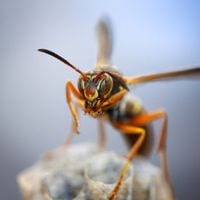Tiny Green Bugs That Bite
In this guide you’ll find a list of tiny green bugs that bite humans, many of them are plant pests.
However, when they come into contact with your skin, they won’t think twice to insert their mandibles and beaks and leave a painful bite.
If they sneak inside your house, you will start to notice that it can get rather itchy after some time. In this post, we will show you which bugs these are, whether or not they bite (you might like to know.
Especially if one is crawling onto your sleeping face whilst at night-time as this is rarely fun). We’ll also provide information about each bug’s bites and how to identify them which might come in handy should you have an encounter with one of these pesky creatures on the street.
Tiny Green Bugs That Bite
The most commonly encountered aphids on houseplants are green, pear-shaped and can be of a darker hue (giving them an almost black appearance).
There are many different variations in the coloration of houseplant-attacking instances of this insect, however.
For example, some are grey and bumpy in texture while others may be transparent with wings that they use to fly from plant to plant.
1. Green Thrips

If you’ve got a garden in your property, then chances are that you’re familiar with all the bugs that can pop up and affect your plants, from Japanese beetles to worms.
If a lot of them are on your rose bush, it may be an indication that they have thrips (which feed on young buds and leaf ends).
Now thrips come in colors like yellow and black (not just black) – but even so it is difficult to see the bug clearly because they typically hide inside narrow openings of flowers or buds.
Thrips damage the plant by drying of leaves and stalling its growth for about 1-4 weeks. To get rid of them, spray water mixed with neem oil and dish soap into the roses.
Thrips will bite humans. It’s how they determine if the thing they landed on is a plant or not. If a thrip lands on you, it might give you a little nibble – but don’t worry – you won’t be harmed because they don’t bite to suck blood or stick anything into your skin!
Thrips are pretty tough and resilient – and capable of living indoors. This typically occurs when someone brings in some Thrips from outdoors, then inadvertently introduces those bugs to their home or greenhouse.
2. Pale Green Assassin Bug

Pale green assassin bugs are common in yards and gardens of the Eastern United States. Native to North America, these bugs live during the summer months.
Pale green assassin bugs are green and grow between 12 and 18 mm in size, but unlike other types of assassin bugs, they don’t damage plants.
However, when their numbers begin to increase pale green assassin bugs can find their way inside your home by sneaking through small gaps and cracks on walls, windows and doors that are left open around the edges.
The easiest way to keep them out is to seal up those narrow gaps using caulk or putty. Pale green assassin bugs are pretty, but they can be inconvenient.
Like other assassin bugs, these insects are aggressive by nature and possess strong mouth parts with a proboscis or beak on their mouths.
Their bites might hurt a little bit at the beginning and cause skin irritation, itchy bumps and swelling for a couple of days.
However, on the bright side, pale green assassin bug bites do not transmit any diseases so you don’t have to worry about having chagas disease.
3. Green Leafhoppers

Green leafhoppers are tiny green bugs that grow up to 3-4 mm in size and their coloring can vary depending on their host plant.
On the leaves of some plants, they may be yellow or brownish, while on other plants they may be green.
If you see these tiny bugs in your garden, it might be an indication that there is something wrong with the plant.
Leafhoppers easily camouflage themselves to help them blend in with the vibrant color patterns of their host plants.
But since these pesky pests feed by transferring large amounts of liquid from one part of a plant to another this behavior appears as discolorations or blemishes that stand out even against the most natural backdrops.
Biting insects such as green leafhoppers are annoying in and of themselves, but it really makes a property owner mad when they see bites or scars all over the place in their home.
If a biting bug is trying to get into your home, the best way to prevent them from entering is by installing window treatments like curtains or shades because they’re aesthetically pleasing and will keep out the bugs when closed.
4. Katydids

Green katydids, like other similar creatures, are insects that have wings and live outside in warm weather during the summer.
They are green and crickets get their name from the sound they make to signal their presence in the grass, which is called chirping.
Chirping is produced by rubbing parts of their bodies together. This can be a nuisance for some people but it is generally tolerated by most because green katydids mostly stay outdoors.
Though these insects can be found all over the world except for Hawaii, you might find them more frequently in North America than anywhere else.
Katydids do bite, but only if they have been aggravated or feel threatened. These bugs are not aggressive, and in fact many people keep them as pets.
The bites of katydids are rare, but they can be very painful like mosquito bites. If you’re unfortunate enough to be bitten by one, there will not be any welts or swelling around the affected area.
Wash the affected wound with warm water and soap, and consider applying a generic ointment if deemed necessary.
5. Green Tiger Beetles

Green tiger beetles or the six-spotted green tiger beetle is a gorgeous looking beetle that helps rid your garden of maggots and insects.
The general location where you might find these beetles are in your Eastern and Midwest area! This particular beetle loves to live near jungles so unless you’re living near a jungle.
You’ll probably never have to worry about it being in your yard or garden! You will find this stunning insect hanging around lampposts emitting light as they hunt down other bugs and become attracted to the lights.
Due to their strong, sharp mandibles, green tiger beetles can bite humans. But these beetles typically bite only when they sense danger or when someone tries to handle them.
Bites from green tiger beetles do not cause any type of infection or disease in humans. The best ways to deal with a green tiger beetle bite are to wash the area that has been bitten with warm water and then apply antiseptic straight into the wound caused by its mandibles.
Conclusion
Tiny green bugs that bite. Among the little green bugs, it’s the dogbane leaf beetle which is mostly poisonous. They do not bite, however they do secrete toxins that are deadly.
Low to the ground near your plants are some tiny green guys, who you might’ve thought were harmful due to how close they get to you.
There are two of them – fig beetles and June beetles. Contrary to popular opinion however, neither of these guys bite humans.
Related Posts


